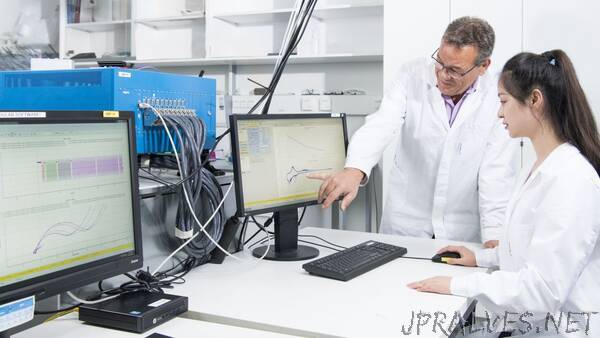
“Nickel-rich cathode and ionic liquid electrolyte enable extremely high energy density with good stability - researchers report in Joule magazine
A new type of lithium metal battery offers an extremely high energy density of 560 watt hours per kilogram with remarkably good stability. For this purpose, researchers at the Helmholtz Institute Ulm (HIU), founded by the Karlsruhe Institute of Technology (KIT) in cooperation with the University of Ulm, have used a promising combination of cathode and electrolyte: the nickel-rich cathode allows a lot of energy per mass to be stored, the ionic liquid electrolyte ensures that the capacity is largely retained over many charging cycles. The team reports on the record-breaking lithium metal battery in the magazine Joule (DOI: 10.1016 / j.joule.2021.06.014 )
Lithium-ion batteries are currently the most common solution for mobile power supply. However, the technology reaches its limits when it comes to certain requirements. This is especially true for electromobility, where light, compact vehicles with long ranges are in demand. Lithium metal batteries are an alternative: They are characterized by a high energy density, which means that they store a lot of energy per mass or volume. But their stability poses a challenge - because the electrode materials react with common electrolyte systems.
Researchers at the Karlsruhe Institute of Technology (KIT) and the Helmholtz Institute Ulm - Electrochemical Energy Storage (HIU) have now found a solution. As you report in Joule magazine, you are using a promising new combination of materials. They use a low-cobalt, nickel-rich layered cathode (NCM88). This offers a high energy density. With the commonly used commercially available organic electrolyte (LP30), however, the stability leaves a lot to be desired. The storage capacity decreases as the number of charging cycles increases. Why this is so, explains Professor Stefano Passerini, Director of the HIU and head of the battery electrochemistry research group: “In the LP30 electrolyte, particle cracks occur on the cathode. The electrolyte reacts within these cracks and destroys the structure. In addition, a thick, moss-like lithium-containing layer forms on the cathode. ”The researchers therefore used a non-volatile, non-flammable ionic liquid electrolyte with two anions (ILE) instead. “With the help of the ILE, the structural changes in the nickel-rich cathode can be significantly reduced,” reports Dr. Guk-Tae Kim from the Battery Electrochemistry Research Group at HIU.
88 percent capacity retained over 1,000 charge cycles
The results: With the cathode NCM88 and the electrolyte ILE, the lithium metal battery achieves an energy density of 560 watt hours per kilogram (Wh / kg). It initially has a storage capacity of 214 milliampere hours per gram (mAh / g); 88 percent of the capacity is retained over 1,000 charging cycles. The Coulomb efficiency, which indicates the ratio between withdrawn and supplied capacity, averages 99.94 percent. Since the presented battery is also characterized by a high level of safety, the researchers from Karlsruhe and Ulm have thus taken an important step on the way to carbon-neutral mobility.
Original publication (Open Access)
Fanglin Wu, Shan Fang, Matthias Kuenzel, Angelo Mullaliu, Jae-Kwang Kim, Xinpei Gao, Thomas Diemant, Guk-Tae Kim, and Stefano Passerini: Dual-anion ionic liquid electrolyte enables stable Ni-rich cathodes in lithium metal batteries. Joules. Cell Press, 2021. DOI: 10.1016 / j.joule.2021.06.014”
